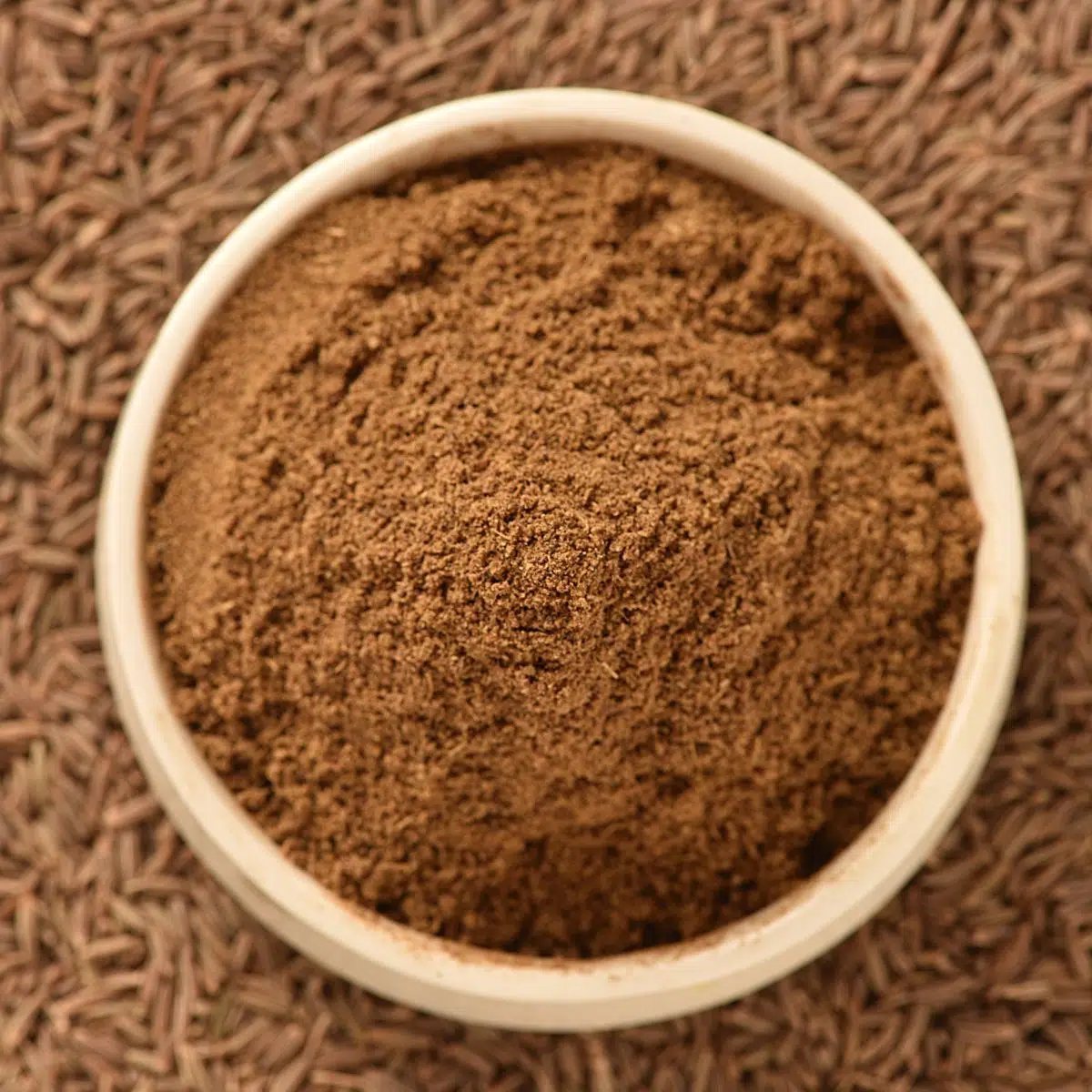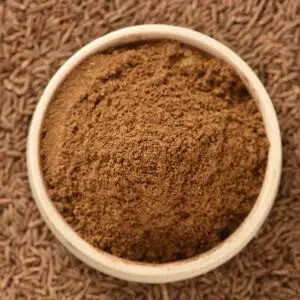Try a cumin substitute from this list the next time you find yourself without this popular spice mid-recipe! It packs a punch of flavor and aromatics that many dishes would not be complete without. But don't worry about running to the store, you may have one of these easy cumin substitutes waiting in your spice cabinet!
Best Cumin Substitute
Cumin has one of the most recognizable tastes and aromas. This bold earthy spice has a natural warmth to it that enhances the flavor of meat, stews, and sauces. Without it, you really would have a bland dish.
Therefore, while it may seem tempting to leave out a spice if you don’t have it on hand – I don’t recommend it. Rather than forgo the bold flavor of your recipe, try one of these amazing substitutes for cumin.

Jump to:
1. Coriander
Coriander has a bold flavor that is reminiscent of cumin. Which makes sense since these two spices are cousins.
Like cumin, the bold flavor of coriander is also popular in Mexican cuisine. Therefore, you will probably recognize its taste and aroma if you love Mexican food.
In addition, coriander is used in Indian and Thai cooking. It is one of the main spices used in making curry powder.
While coriander and cumin share many similar flavor notes, coriander is not as spicey as cumin. However, it is still best to start with only ½ of a teaspoon of coriander in place of 1 teaspoon of cumin. You can use ground coriander or coriander seeds.
2. Ground Coriander + Cayenne
As mentioned above, coriander will work wonderfully on its own. Especially if you prefer a flavor with a little less kick than cumin.
If you want that bold kick of flavor that comes from the spice in cumin though, coriander alone won’t offer it. However, this can be remedied with another common spice in your cabinet – cayenne pepper.
Follow the direction above for subbing coriander for cumin and then add a pinch of cayenne pepper.
3. Caraway Seeds
Caraway seeds are commonly found in Middle Eastern cooking. Like cumin, they have a complex and rich flavor profile.
These flavorful seeds are earthy with notes of pepper, citrus, and anise. It is a flavor that has a bit of a zing, with a sweet softer undertone.
These seeds are used to add bold flavor to rich sauces and dishes with pasta and rice.
Use ½ teaspoon of caraway seeds in place of 1 teaspoon of cumin powder. If the flavor is not bold enough, add more slowly.
4. Fennel Seeds
When heated up, fennel seeds release a bold aroma that is warm and earthy. Much like what cumin smells like when heated up.
However, in addition to its earthy aroma and flavor, fennel has the added flavor of anise. If you are unfamiliar with anise, it has the same flavor as licorice. Fennel also has a bit of sweetness.
While there are some flavor differences this bold spice is still a great choice as a substitute for cumin. It works particularly well in tomato sauce and curries.
As with the other substitutes, start with half the measurement the recipe calls for. The flavor of fennel goes a long way.
5. Taco Seasoning
If you don’t have cumin in your spice cabinet peek in your pantry to see if you have any taco seasoning. Yes, the little packet with the perfect measurement of spices to kick up the flavor of a plain pound of ground beef.
Whether it is a generic taco seasoning packet or Taco Bell brand, this mixture of spices is a great choice to use instead of cumin powder. Especially when making a Mexican dish.
Most taco seasonings are made with chili powder, garlic powder, onion powder, salt, and sugar. The main seasoning, chili powder, is made with cumin. Therefore, when you smell cumin on its own it may remind you of taco seasoning.
In most recipes, you can use taco seasoning in a 1:1 ratio for cumin. However, if you are worried about it shifting the flavor too much start with ½ a measurement and add more as desired.
6. Chili powder
As mentioned above, chili powder contains cumin. Chili powder is a blend of dried chili flakes, cumin, garlic powder, onion powder, oregano, and black pepper.
Like taco seasoning, the mixture is a great choice for Mexican dishes. Especially those that you want to have a nice bold flavor.
Since chili powder is not balanced with the sugar used in taco seasoning it will often be a bit spicier though, so keep that in mind when using it as a substitute. The red flavor may also add a bit of color to your dish.
Start with ½ teaspoon of chili powder for 1 teaspoon of cumin powder.
7. Chipotle Powder
Chipotle powder is made from dried and smoked chili peppers. This is the powder that is often used as a base for chili powder.
However, since it is not mixed with the other spices it has a distinctly different flavor. You will notice that chipotle powder has a smoky flavor with a bit of heat.
Even though it has some heat in the flavor it is a different type of flavor than cumin. Therefore, you will notice some differences in the final taste. However, it is a good option for adding a smoky twist to a dish.
Use ½ teaspoon of chipotle powder in place of 1 teaspoon of cumin powder.
8. Paprika
Of all the dried chili spices, paprika is the mildest. It has a rich smoky flavor that is more prominent than any spiciness.
Paprika is mostly identified as because of its rich red color, rather than its flavor. Due to its mild flavor and bold color, this spice is commonly used as a garnish.
Just because it is used as a garnish doesn’t mean it doesn’t work well mixed into the recipe as well. If you want an alternative to cumin that is not as spicy, try paprika. It will add a nice hint of color and a smoky flavor.
You can use a 1:1 ratio for this substitution.
9. Curry Powder
Curry powder is a spice blend that is used to make, curry! This blend is commonly used in Indian cooking, but it has become more popular around the world.
If you have ever used curry powder before then you know it is a bold yellow color. The color comes from the main ingredient – turmeric.
While turmeric is bold visually, it has a very mild taste. Therefore, it is mixed with other spices like cumin, fenugreek, and coriander to get a richer flavor.
Since curry powder is made with cumin it works well in many dishes. However, the flavor will be more subdued, and it will also add a bright yellow hue to your dish.
Curry powder can be used in a 1:1 ratio because of the mild turmeric base.
10. Garam Masala
Another spice blend that originated in India is Garam Masala. This blend is less common in the United States. However, if you are familiar with it and have it on hand it can also be a nice substitute for cumin.
Unlike curry powder, garam masala is not made with turmeric. Therefore, it will not add a yellow hue to your dish. Like curry powder, it includes cumin in its mixture.
In addition, most garam masala blends will include coriander, cardamom, cloves, cinnamon, black peppercorns, nutmeg, and mace. These bold spices will provide a rich flavor that has a similar spicy flavor profile as cumin. The addition of the nutmeg and mace will lend a warm flavor with hints of sweetness.
Start with ½ a teaspoon of garam masala in place of 1 teaspoon of cumin.
11. Star Anise
You may recognize star anise as the star-shaped pods that are used in making mulled wine and ciders during the holidays. However, this distinctly shaped spice also comes in a ground powder form.
The flavor of star anise is quite different from cumin. While it has spicy notes, they are offset by a strong licorice flavor.
Although this spice is not identical to cumin it is a fun way to elevate the flavor of a dish. So, if you have ground star anise in your cupboard give it a try. You can even use the full pods for simmering in sauces or stews.
Use ½ teaspoon of ground star anise or 2 to 3 whole pods to replace 1 teaspoon of cumin.
12. Nigella Seeds
Less common than other substitutes for cumin are nigella seeds. These are seeds that have a slightly bitter flavor. The flavor resembles a blend of cumin, oregano, and onion. There is also a smoky element to them.
This complex flavor pairs well with many of the same foods that cumin would be used to season on its own. Therefore, if you are familiar with nigella seeds and have them available, they are a great alternative to cumin.
Even though these come in seed form rather than a ground powder they can be easily measured in a 1:1 ratio for cumin. However, the little black seeds will be noticeable in your final dish and slightly change the aesthetic.
No matter what you're cooking, we are sure it will come out delicious if you use a cumin substitute from this page! Let us know in the comments below which alternatives you tried and how your recipe turned out!
Do you love a recipe you tried? Please leave a 5-star 🌟rating in the recipe card below and/or a review in the comments section further down the page.
Stay in touch with me through social media @ Pinterest, Facebook, Instagram, or Twitter! Subscribe to the newsletter today (no spam, I promise)! Don't forget to tag me when you try one of my recipes!
📖 Recipe Card
Best Cumin Substitute: Coriander (+ More Easy Alternatives!)
Ingredients
- ½ tablespoon coriander (ground or whole)
- ½ tablespoon caraway seeds
- ½ tablespoon fennel seeds
(Note: 2x or 3x only changes the ingredient list)
Instructions
- It is best to start with only ½ of a teaspoon of coriander in place of 1 teaspoon of cumin.
- Use ½ teaspoon of caraway seeds in place of 1 teaspoon of cumin powder. If the flavor is not bold enough, add more slowly.
- As with the other substitutes, start with half the amount of fennel in place of cumin. The flavor of fennel goes a long way.



Comments
No Comments